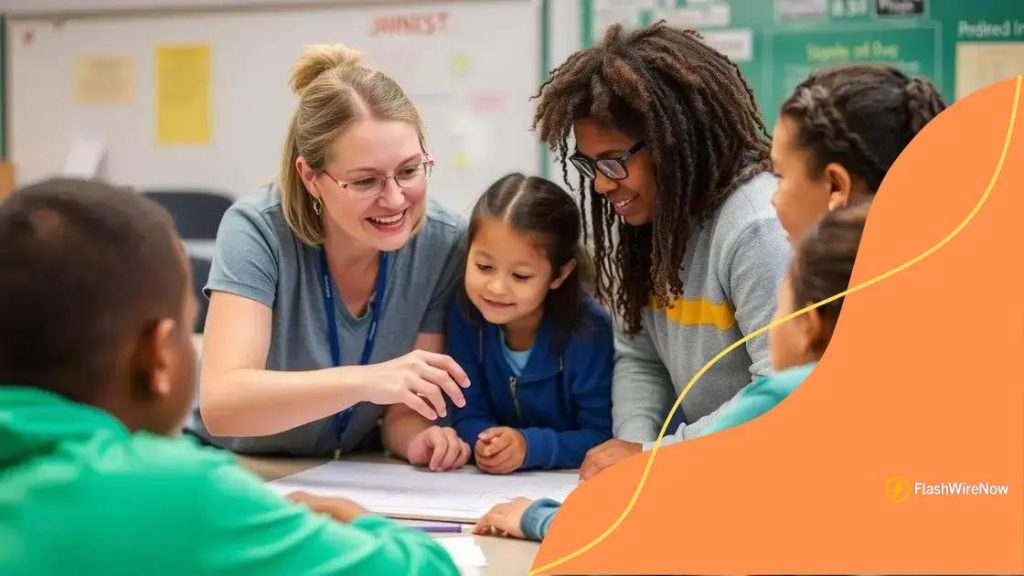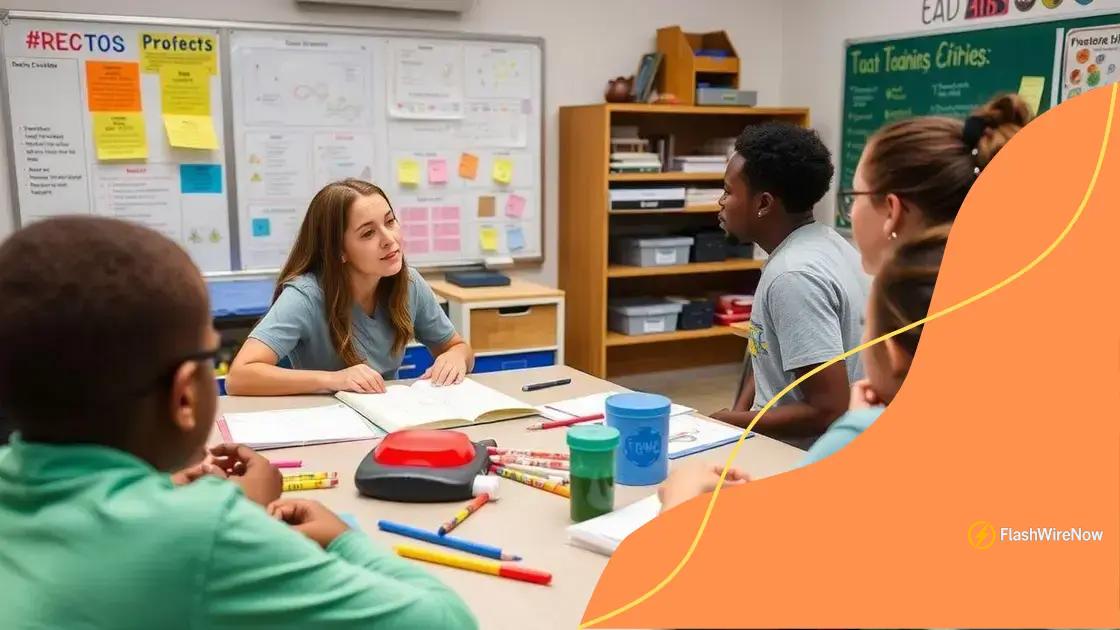Project-based learning assessment methods that enhance skills

Anúncios
Project-based learning assessment methods engage students through real-world projects, enhancing their critical thinking, creativity, and collaboration skills while providing practical applications of their knowledge.
Project-based learning assessment methods are reshaping how we evaluate student understanding and skills. Have you ever wondered how engaging students in real-world projects could enhance their learning experience? This article will dive into innovative methods that transform traditional assessments.
Anúncios
Understanding project-based learning assessment
Understanding project-based learning assessment is crucial for educators aiming to enhance student engagement and comprehension. This method shifts the focus from traditional exams to evaluating students through real-world projects.
By integrating assessments into project-based learning, teachers can gain insight into students’ abilities to apply knowledge practically. This assessment style encourages creativity and critical thinking, fostering a deeper understanding of the subject matter.
Key Concepts of Project-Based Learning Assessment
Project-based learning assessment is built on several key concepts:
Anúncios
- Real-world relevance: Projects connect learning to real-life situations, making education meaningful.
- Student agency: Students have the freedom to choose projects that interest them, promoting motivation.
- Collaboration: Working in groups allows students to share ideas and learn from one another.
- Reflection: Assessments often include self-evaluation, encouraging students to reflect on their learning journey.
These concepts work together to create a rich learning environment. By focusing on practical applications of knowledge, teachers can foster a classroom culture that values well-rounded skill sets.
Implementing Project-Based Assessment
To effectively implement project-based assessments, educators need to consider several strategies to ensure success. One essential aspect is setting clear expectations for students. When students understand the assessment criteria, they can focus on meeting those benchmarks.
Another important factor is providing support throughout the project. This can include offering resources, guidance, and feedback at various stages of the project. Such support helps students stay on track and encourages their development of problem-solving skills.
A structured timeline for projects is also beneficial. By establishing deadlines for phases of the project, students can manage their time effectively, making the process less overwhelming and more productive. Understanding these elements will allow educators to create a successful and engaging project-based learning environment.
Key benefits of project-based assessment methods
Key benefits of project-based assessment methods include improved engagement and enhanced learning outcomes for students. This approach allows students to apply their knowledge in real-life contexts, making learning more relevant and exciting.
One major advantage is that project-based assessments foster critical thinking skills. Students are required to analyze problems and develop solutions, which prepares them for challenges they’ll face outside the classroom. In addition, collaboration plays a vital role in project-based learning. Working together in teams helps students develop interpersonal skills that are essential for future success.
Enhanced Skill Development
Project-based assessment methods promote various skills including:
- Creativity: Students are encouraged to think outside the box and come up with innovative solutions.
- Time management: Handling project deadlines teaches students to prioritize tasks.
- Research skills: Students learn to gather information and evaluate sources effectively.
- Communication: Presenting their projects enhances both written and verbal communication skills.
Another noteworthy benefit is the opportunity for self-directed learning. Students take charge of their learning process, allowing them to build confidence as they navigate project challenges. This independence is critical for lifelong learning.
Immediate Feedback and Reflection
With project-based assessments, students receive immediate feedback from peers and teachers. This feedback helps them understand their strengths and areas for improvement. Moreover, reflecting on their work encourages students to think critically about their process and outcomes.
When students reflect on their projects, they gain valuable insights into their own learning preferences and styles. This self-awareness can lead to improved academic performance and a greater passion for learning. All these benefits contribute to a more dynamic and effective learning environment.
How to design effective project assessments

How to design effective project assessments requires careful planning and consideration of various factors. An effective assessment not only evaluates student performance but also enhances their learning experience.
First, it’s crucial to define clear objectives. Knowing what you want students to achieve helps guide the design process. These objectives should align with the overall curriculum and learning goals.
Developing Assessment Criteria
Next, create assessment criteria that outline the expectations for student projects. Good criteria should be specific, measurable, attainable, relevant, and time-bound (SMART). This clarity helps students understand what is required of them.
Some key elements to include in the criteria are:
- Content mastery: Evaluating how well students understand the subject matter.
- Creativity: Assessing the originality and innovation of their ideas.
- Collaboration: Measuring how effectively students work together in teams.
- Presentation skills: Looking at how well students communicate their findings.
Effective communication of these criteria is also important. Share them with students early on so they have a clear understanding of what is expected throughout the project.
Incorporating Feedback Mechanisms
Incorporating feedback mechanisms is essential for ongoing assessment. Regular check-ins allow students to receive guidance and adjust their work based on suggestions. This process not only improves the project but also fosters a growth mindset in students.
Utilizing peer reviews can also be beneficial. When students evaluate each other’s work, they gain different perspectives and learn from their peers. This interaction deepens their understanding and encourages collaborative learning.
Finally, consider providing opportunities for self-assessment. Allowing students to reflect on their own work enhances their critical thinking skills. It encourages them to take ownership of their learning process, helping to solidify their understanding of the material.
Challenges in implementing project-based assessment
Challenges in implementing project-based assessment can hinder its effectiveness in the classroom. While this method has many benefits, there are obstacles that educators must navigate to ensure successful implementation.
One significant challenge is the need for adequate training. Teachers may not be familiar with designing and evaluating project-based assessments. Without proper training, they might struggle to create effective projects that engage students.
Time Constraints
Another common issue is time management. Preparing and facilitating project-based assessments often takes more time than traditional assessments. Teachers may find it difficult to fit these projects into an already packed curriculum.
Moreover, assessing projects can be time-consuming. Evaluating multiple aspects, such as creativity, collaboration, and content mastery, requires careful consideration. This can lead to stress for teachers who are already pressed for time.
Resource Availability
Furthermore, limited resources can be a significant barrier. Not all schools have access to the materials or technology needed to support project-based learning. This lack of resources can prevent students from fully engaging in projects, limiting their learning experiences.
In addition to external resources, teachers may also lack the support from colleagues or administration. Collaboration among teachers can enhance project-based assessments by allowing for shared ideas and strategies.
Lastly, student resistance can arise. Some students may be unaccustomed to this style of learning and may prefer the familiarity of traditional assessments. Overcoming this resistance requires patience and encouragement from teachers, fostering an open mindset toward learning.
Real-life examples of project-based assessments
Real-life examples of project-based assessments illustrate how effective and engaging this method can be for students. These examples provide insight into practical applications and inspire educators to implement similar strategies in their classrooms.
One notable example is a community garden project where students design, plan, and create a garden on school grounds. This project encourages students to research plants, understand ecosystems, and collaborate with local experts. Students gain hands-on experience in gardening while enhancing their understanding of biology and environmental science.
Science Fair Projects
Another great example comes from science fairs. Students create experiments to test hypotheses, documenting their process and results. These projects allow students to practice the scientific method while showcasing their findings. They learn how to present their work and answer questions from judges and peers, developing confidence and communication skills.
A classic project that many schools use involves creating a historical presentation. Students research a historical event, then create a presentation or performance that brings that event to life. This helps them engage with history in a meaningful way, promoting critical thinking and creativity.
Business Ventures
In some cases, students set up a business. For instance, they might create a school store or a small business that sells products they design. This project teaches them about entrepreneurship, financial literacy, and teamwork. By managing a business, students experience the challenges and rewards involved in running a real enterprise.
These real-life examples demonstrate the richness of project-based assessments. Students learn valuable skills like problem-solving, teamwork, and communication. Each project can be tailored to fit the curriculum, making them versatile and adaptable for different subjects.
Conclusion
Project-based learning assessment methods offer a dynamic way to engage students and enhance their skills. By implementing real-life projects, educators can inspire creativity and critical thinking. While challenges exist, the benefits far outweigh them. Teachers can foster a rich learning environment that promotes collaboration and hands-on experiences. Through various projects, students can truly connect with the material and develop essential life skills.
FAQ – Frequently Asked Questions about Project-Based Learning Assessment
What is project-based learning assessment?
It is an educational approach where students engage in real-world projects to gain deeper knowledge and skills.
How can project-based assessments enhance student engagement?
These assessments provide hands-on experiences that make learning relevant and exciting, motivating students to actively participate.
What are some challenges in implementing project-based assessments?
Challenges include time constraints, resource availability, and the need for proper teacher training.
Can you provide examples of effective project-based assessments?
Examples include community garden projects, science fairs, and student-run businesses that apply learning in practical settings.





